Standing in my backyard one late afternoon, I watched the sunlight dance through the trees, casting soft shadows across the grass. My old corner fence, once sturdy, now looked dull and uninspired. I imagined a space where privacy met style, where a simple fence could become the highlight of the garden rather than just a boundary. That day, I decided to explore creative corner fence ideas that could transform any backyard into a cozy, functional, and visually appealing retreat.
As I dug through design blogs, Pinterest boards, and local garden centers, I realized that a corner fence isn’t just a practical necessity. It’s an opportunity for creativity. Whether you have a small urban garden or a sprawling suburban yard, the right corner fence can redefine your outdoor space, add privacy, and even increase the aesthetic value of your property.
In this guide, I’ll share 10 creative corner fence ideas, complete with practical tips, materials, and inspiration to help you choose the perfect style for your backyard.
Table of Contents
Why Corner Fences Matter in Your Backyard
Corner fences do much more than mark property lines. They enhance privacy by blocking sightlines from neighbors or streets, and they define distinct spaces, creating natural separations for patios, seating areas, or garden zones.
A thoughtfully designed corner fence can serve as a focal point or complement your landscaping, adding aesthetic appeal to your outdoor space. Additionally, corner fences can support plants, vines, and climbing flowers, bringing life and color to what might otherwise be a neglected area. Understanding their role helps you make design choices that balance function and style.
Wooden Privacy Corner Fence
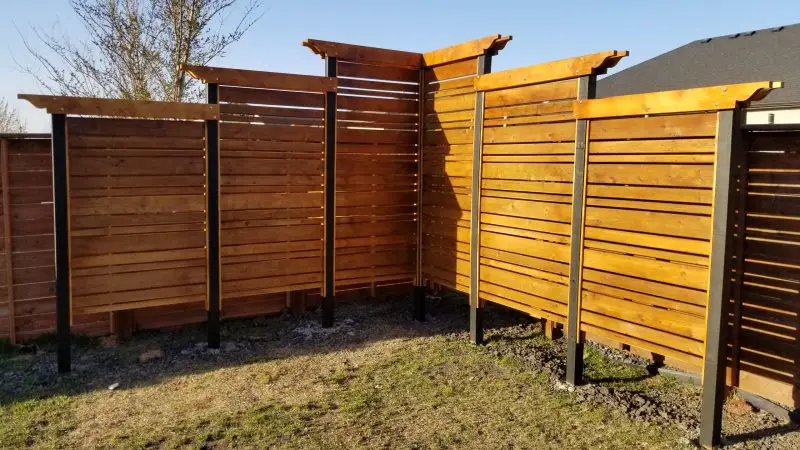
Wooden fences offer a timeless, warm, and versatile option. In corner areas, tall wooden panels provide both privacy and a sense of enclosure. Natural cedar or redwood is particularly durable, resisting rot and weathering, while horizontal slats can add a modern twist.
To create visual interest, consider mixing panel heights or adding lattice panels at the top, which increases height without feeling too enclosed. Staining or painting the wood in earthy tones can tie the fence into the overall backyard design. Wooden privacy fences work well for family spaces, outdoor dining areas, or any backyard seeking a natural, inviting charm.
Metal Corner Fence with Geometric Patterns
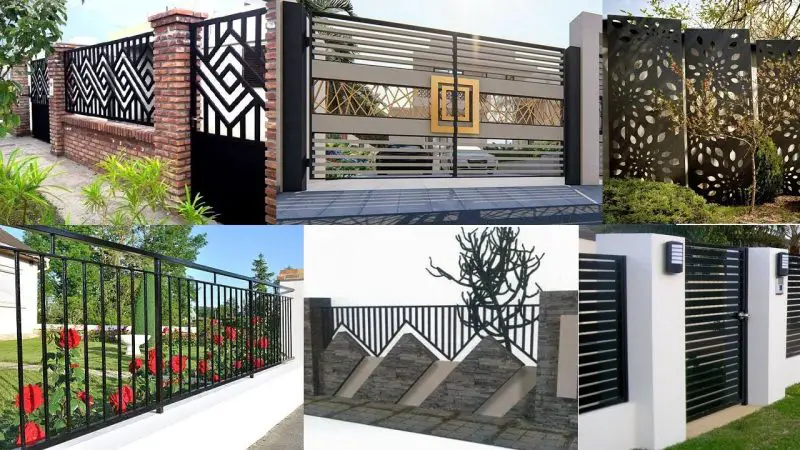
Metal fences such as wrought iron or steel can feature intricate geometric patterns that turn corners into focal points. Powder-coated finishes enhance durability and allow bold color choices.
Combining metal panels with wooden posts adds warmth and stability, and laser-cut patterns inspired by nature or abstract art can make the fence a statement piece. Incorporating subtle LED lighting along the base can showcase the design at night, creating an artistic effect. This type of corner fence suits modern, urban, or minimalist backyards where style and craftsmanship are equally important.
Corner Fence Planter Hybrid
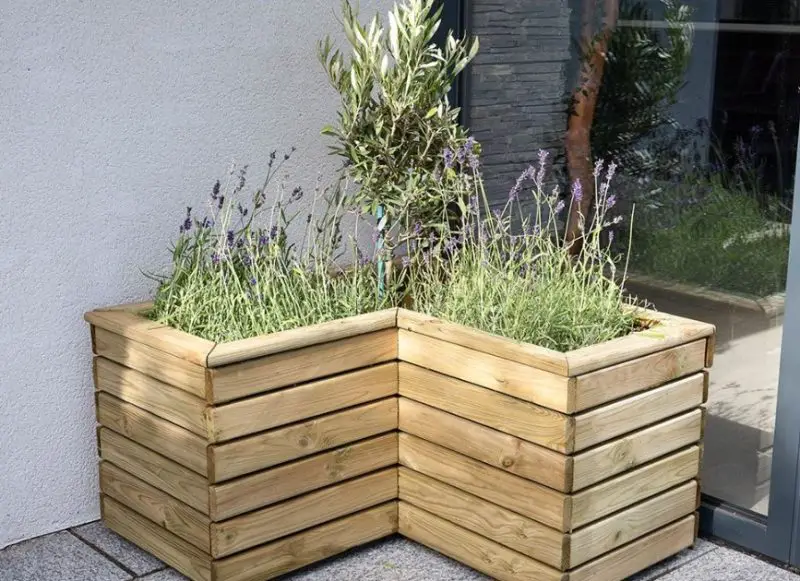
A corner fence that integrates planter boxes is both practical and visually appealing. Raised planter boxes at the base allow for flowers, shrubs, or small trees, softening the corner and adding greenery.
Durable materials such as composite wood or concrete ensure longevity, while climbing vines like jasmine or clematis can grow along the fence, adding vertical interest. Integrating benches into the planter design transforms the corner into a multifunctional space, offering seating while maintaining aesthetic appeal. This solution works particularly well in smaller backyards, where vertical gardening maximizes space while enhancing beauty.
Corner Fence with Horizontal Slats
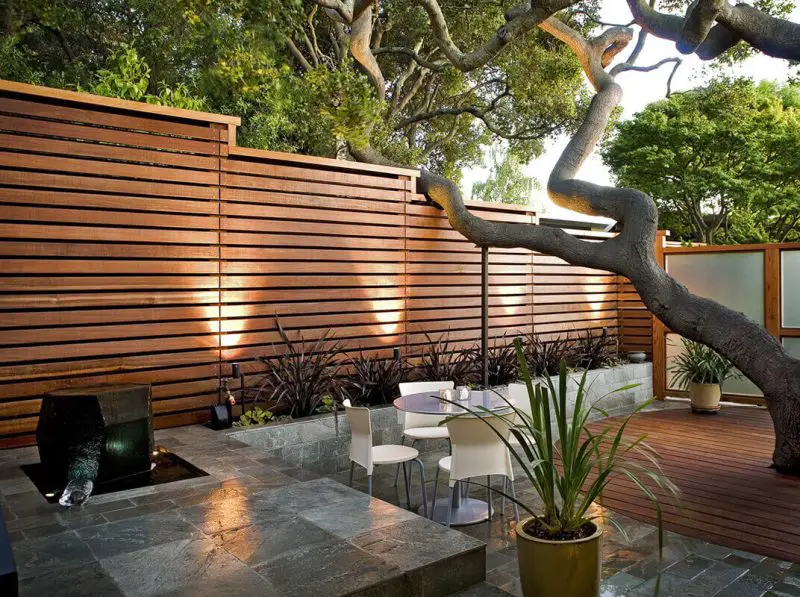
Horizontal slats create a contemporary, streamlined look while still offering privacy. The spacing between slats can be adjusted for partial visibility or airflow, making the space feel open yet protected.
Mixing wood tones adds a layered effect, while decorative post caps provide a polished finish. Staggering slat lengths at corners softens sharp angles, giving the fence a subtle dynamic look. Horizontal slat fences are ideal for modern homes and minimalist landscapes, providing clean lines and a stylish, functional barrier.
Living Green Corner Fence
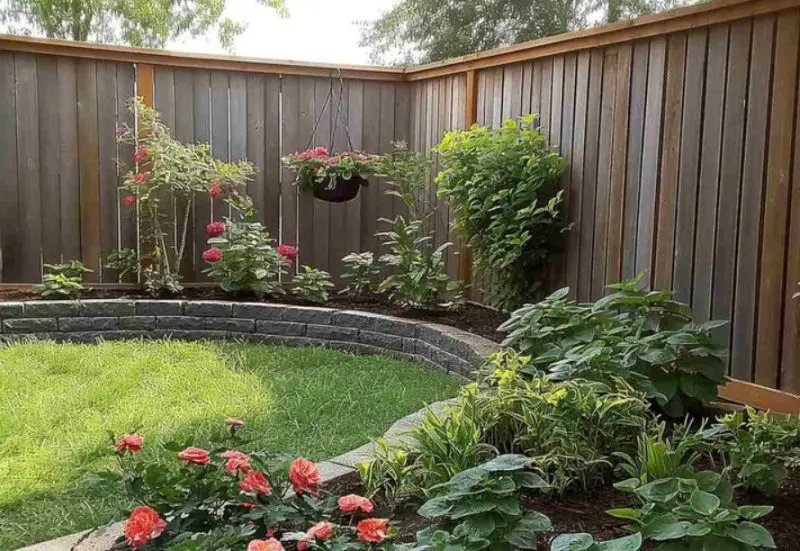
A living green fence uses plants to form a natural barrier, offering privacy and environmental benefits. Evergreen shrubs, bamboo, or dense hedges can create a lush, eco-friendly corner.
Selecting plant species suitable for your climate ensures long-term success, while combining taller and shorter plants creates a layered appearance. Using trellises or wire frames allows climbing vines to grow vertically, adding texture and color. Living fences not only enhance backyard aesthetics but also provide habitats for birds and pollinators, making them an excellent choice for eco-conscious homeowners.
Rustic Log Corner Fence

Rustic log fences bring a natural, woodland feel to your backyard. Made from raw logs or branches, these fences emphasize texture and irregularity.
Using logs of different diameters adds visual interest, while treating the wood ensures durability without compromising its rugged charm. Integrating lanterns or simple seating near the corner further enhances the cozy, rustic ambiance. This type of fence is perfect for country homes, lakeside cabins, or backyards surrounded by trees, complementing a natural outdoor setting.
Corner Fence with Integrated Seating
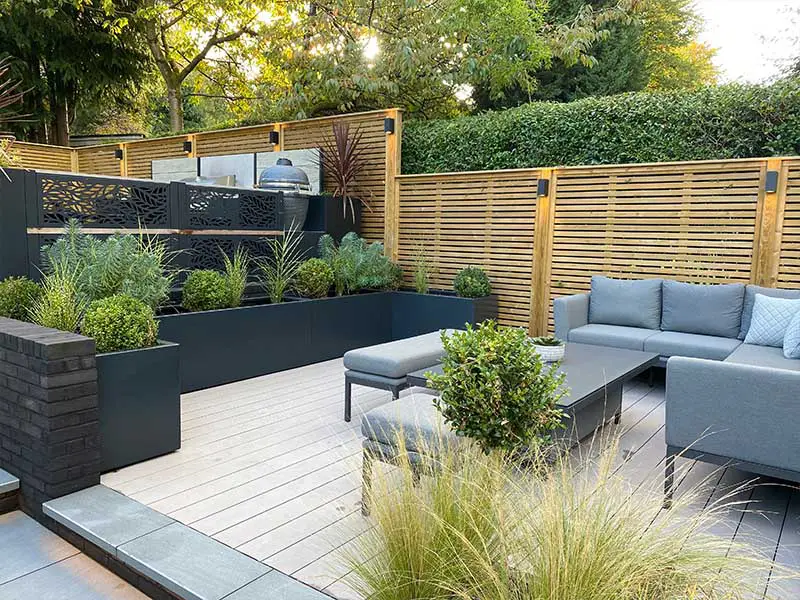
A corner fence with built-in seating transforms an overlooked area into a functional, inviting retreat. Benches, ledges, or storage boxes can be incorporated directly into the fence, maximizing space while adding utility.
Using weather-resistant wood or composite materials ensures durability, and adding cushions or pillows increases comfort. Complementing seating with integrated planters or lighting enhances ambiance, making the corner a favorite spot for relaxation. This design is especially suitable for patios or garden corners where entertaining or quiet moments are valued.
Modern Minimalist Corner Fence
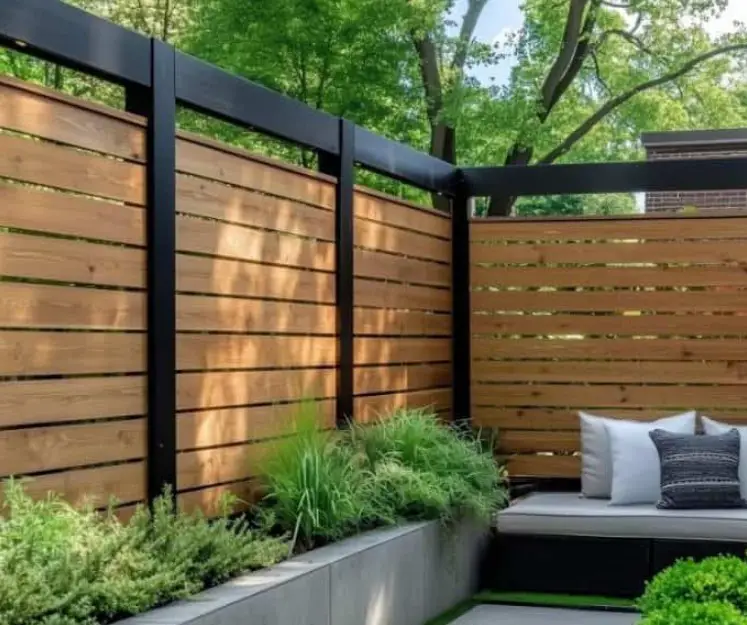
Minimalist corner fences emphasize clean lines, neutral colors, and simple materials like metal, concrete, or smooth wood. The design focuses on elegance and simplicity, with uncluttered corners and consistent materials creating a cohesive look.
Low lighting or subtle planters can soften edges without disrupting the minimalist aesthetic. Modern minimalist fences work well in contemporary homes or urban backyards, providing privacy while maintaining a sleek, sophisticated appearance.
Corner Fence with Decorative Screens
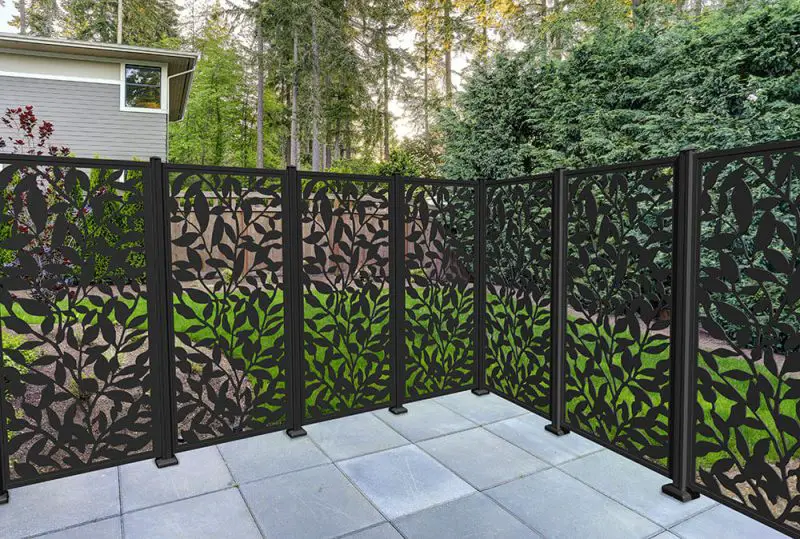
Decorative screens add artistic flair to corner fences. Materials such as wood, metal, bamboo, or composite panels can feature intricate patterns, cutouts, or perforations.
Placing screens near focal points, like fountains or seating areas, enhances visual impact, while combining solid and patterned panels introduces movement and interest. Pairing screens with climbing plants can transform corners into living art walls, blending function and beauty. Decorative screens are ideal for backyards used for entertaining or areas where privacy is desired without sacrificing style.
Corner Fence with Lighting Integration
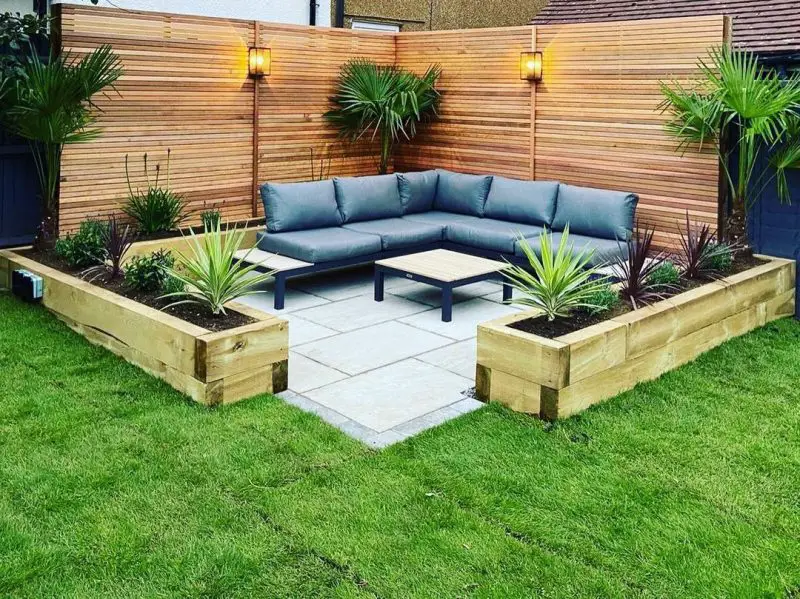
Lighting can dramatically transform a corner fence at night. Incorporating LED strips, lanterns, or solar-powered lights into the fence design adds warmth and visual appeal.
Warm lights create a cozy atmosphere, and motion sensors or dimmers enhance convenience. Strategically highlighting textures, patterns, or climbing plants along the fence creates a magical effect after sunset. This approach works perfectly in evening gathering spots, garden paths, or any backyard area meant for entertainment or relaxation after dark.
Tips for Choosing the Right Corner Fence
Selecting the perfect corner fence requires balancing function, aesthetics, and practicality. Consider the primary purpose of the fence, whether it is privacy, creating a focal point, or supporting plants. Material choice is critical, ensuring it can withstand local climate conditions and align with your maintenance preferences.
Harmonizing the fence style with the home and backyard design ensures visual consistency, and budget considerations should account for installation, upkeep, and optional enhancements such as lighting or planters. Finally, checking local building codes ensures that your fence is compliant and avoids potential issues.
Maintenance and Longevity
To preserve the beauty and functionality of your corner fence, regular maintenance is essential. Wooden fences benefit from cleaning and periodic treatments with sealants, stains, or paint to prevent rot. Metal fences should be inspected for rust or corrosion and repainted as necessary.
Living green fences require pruning to maintain shape and prevent overgrowth. Checking structural elements, such as screws, bolts, and panels, ensures long-term stability. Thoughtful maintenance keeps your corner fence looking attractive while extending its lifespan.
Final Thoughts
A creative corner fence can transform your backyard, turning a neglected edge into a captivating, functional space. Whether you prefer rustic logs, modern minimalist designs, or living green walls, the right corner fence enhances privacy, aesthetics, and enjoyment of your outdoor area.
By considering style, material, and functionality, you can design a corner that becomes the heart of your backyard, providing beauty, comfort, and a space to relax or entertain. Even small corners can become standout features that reflect your personality and taste, proving that a fence can be more than a boundary—it can be the highlight of your outdoor sanctuary.
Frequently Asked Questions About Corner Fence Ideas
What are the best materials for a corner fence?
The best materials depend on your priorities. Wooden fences offer warmth and natural charm, while metal fences provide durability and a modern look. Composite and vinyl fences require less maintenance, and living green fences create natural privacy while supporting plants and wildlife.
How high should a corner fence be?
Corner fence height varies based on function and local regulations. For privacy, 6 to 8 feet is common. If the goal is aesthetic or partial enclosure, 4 to 5 feet can work. Always check local zoning laws before installation.
Can I integrate plants into my corner fence?
Yes, many corner fences can incorporate plants. Raised planters, trellises, or climbing vines can be added to wooden, metal, or hybrid fences. Living fences made of hedges or bamboo are also excellent for creating natural green barriers.
How much does it cost to build a corner fence?
Cost depends on materials, design complexity, and labor. Wooden fences are generally mid-range, metal or decorative screens cost more, and living fences vary depending on plant selection. Simple DIY projects can reduce expenses, but professional installation ensures durability.
Do corner fences require maintenance?
Yes. Wooden fences benefit from periodic staining or sealing. Metal fences may need rust prevention, and living fences require pruning and care for plants. Regular inspection helps maintain both aesthetics and functionality.
Can a corner fence improve my backyard’s appearance?
Absolutely. A creative corner fence can act as a focal point, complement landscaping, and add style. Options like decorative screens, integrated seating, or lighting can make corners inviting and visually appealing.
Are there eco-friendly corner fence options?
Living fences made from hedges, bamboo, or climbing plants are eco-friendly. Recycled materials for wooden or metal fences and low-impact finishes can also reduce environmental impact. Incorporating plants enhances biodiversity in your backyard.






